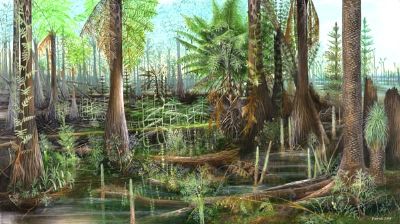by Larry
February, 2006Fossil Fuel OriginsWhile there is not complete unanimity among geologists and other scientists (a few maintaining oil came from primordial, extraterrestrial, and/or nonliving origins), since all fossil fuels have traces of organic material (such as pollen) in them, it is generally accepted that petroleum, natural gas, and coal derive from ancient living things compacted under intense pressure for millions of years. In the process, natural forces largely reduced the bodies of billions or, more likely, trillions of organisms to their constituent hydrocarbon compounds which, squeezed together, formed coal or the rock from which, with further natural processes, oil derived. According to pitwork.net, 325-280 million years ago giant fern forests and swamps dominated earth's landscape. As millions and millions of individual plants died, their material settled into layers that time and pressure first turned into peat. Oxygen and hydrogen were lost under the great impetus of higher layers, first of sand, mud, and water, and later the enormous weights and impact of thick stone strata, earth crust movements, and volcanic actions. Ultimately, the former vegetable matter was thus reduced largely to its constituent carbon molecules in rock-hard seams of coal.
Oil is usually thought to derive from shale and other hydrocarbon-rich sediments which, under great heat or pressure, yield petroleum deposits. Those petroleum producing sediments, in turn, are believed to have been formed from countless microscopic bodies of plankton buried under succeeding geological layers in the course of the 600 million years or more that life has been in the planet's oceans. In fact, according to crystalinks.com, primitive plankton existed in the earth's seas 3.7 billion years ago. Within only the last 200 years or less, our species is considered responsible for retrieving and burning approximately half of the entire 600+million year (or perhaps up to 3.7 billion year) heritage of petroleum reserves. At current rates of expenditure, most of the balance is expected to be depleted in only the next quarter- to half-century. All three cited fossil fuels, when burned, produce carbon dioxide, the leading greenhouse gas. In the atmosphere it helps prevent solar energy from being radiated back to space, thus warming the surface of the globe and resulting in climate change (with uncertain regional variations). Currently, studies of nearly two-mile long Antarctic ice cores, composed of ice layers formed as far back as 650,000 years ago, show that atmospheric carbon dioxide levels are now, per Scientific American, 27% above their highest levels from that long a period in the earth's past. |
